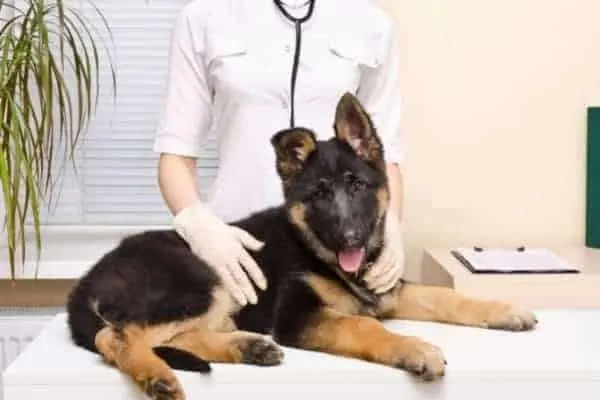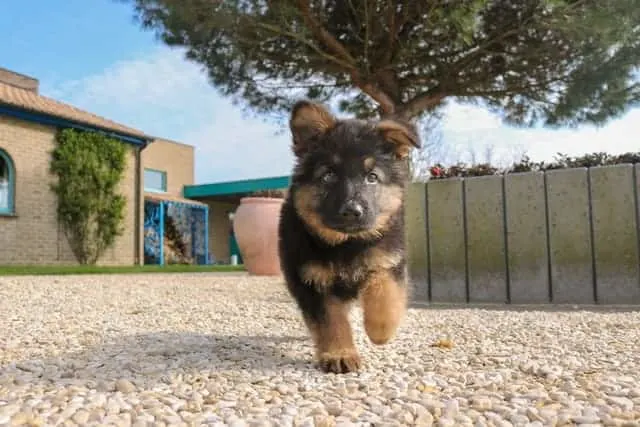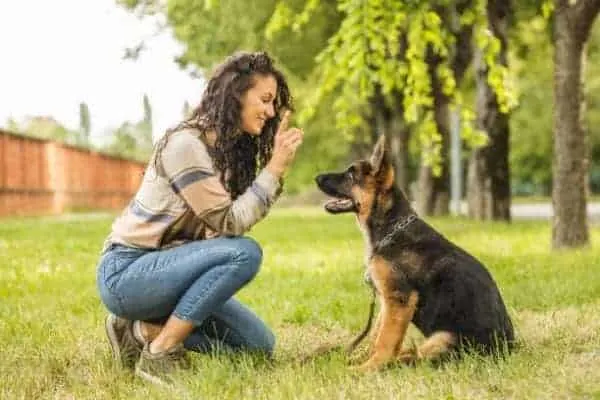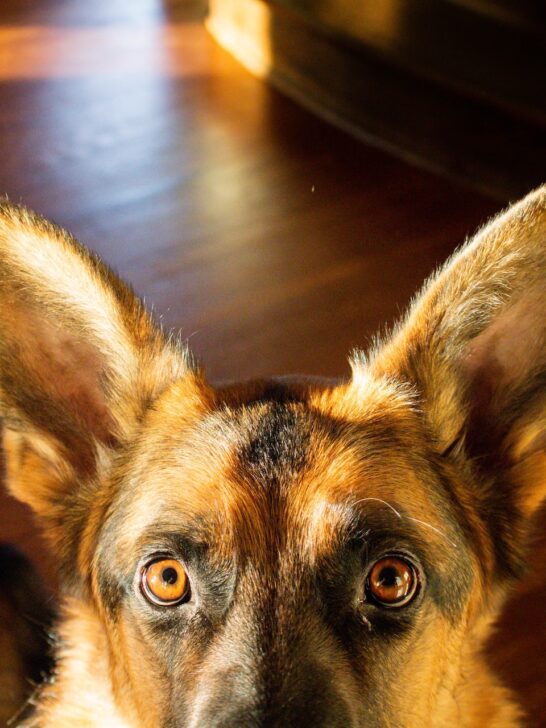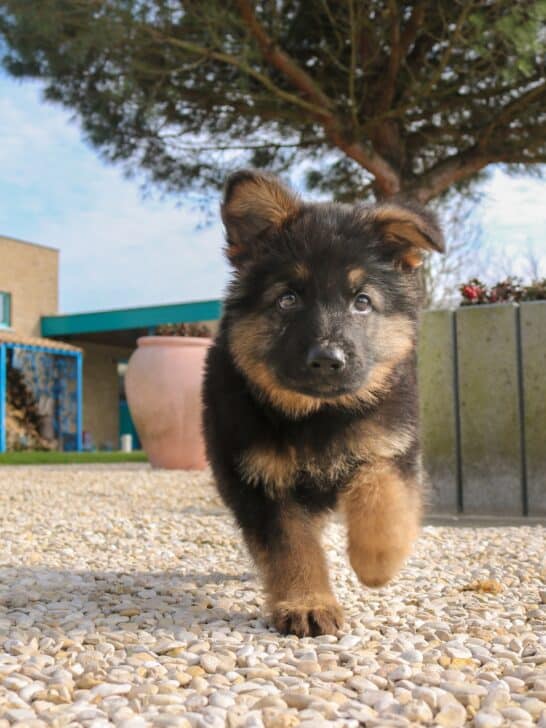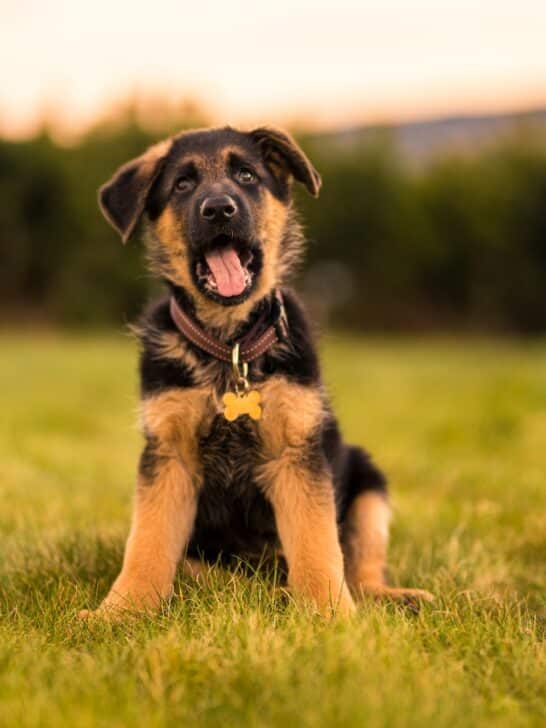6 Month Old German Shepherd: What to Expect as Your German Shepherd Puppy Gets Big
For many dog lovers around the world, there is no better canine companion on the planet than the German Shepherd dog.
The German Shepherd dog breed first became popular with pet dog owners after the movie “The Silent Call” was released in 1921.
This film starred a German Shepherd named Strongheart who went on to become a household name.
According to the American Kennel Club (AKC), the German Shepherd is still the second most popular pet dog choice for Americans today.
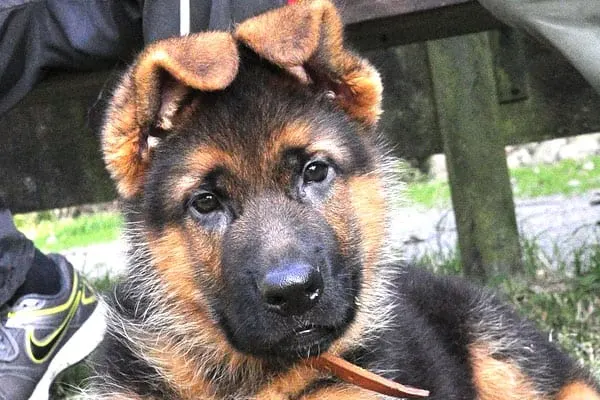
6 Month Old German Shepherd
At six months old, a German Shepherd is really starting to look like a fully grown adult GSD.
But your dog is still a puppy on the inside, and this is very important to remember. Your dog still has a lot of growing to do on the inside!
A six-month-old German Shepherd puppy is going to need a lot of socialization and structured crate training and enough gentle exercise and play to keep all that energy under control.
What to Expect as Your German Shepherd Turns Six Months Old
German Shepherds are really smart, strong dogs, which can mean they are a handful to raise and train as they grow up and get bigger.
If you are caring for a German Shepherd puppy right now or have ever done so in the past, you already know this!
One of the biggest areas of anxiety for first-time German Shepherd owners is whether what they are experiencing with their dog is normal or not.
For example, is it normal for a six-month-old German Shepherd puppy to be biting everything in sight? How about if a six-month-old German Shepherd puppy whines and barks a lot?
What about appetite, portion size, and treats for a 6 month old German Shepherd? When should you transition to adult dog food and an adult dog portion size?
And what about that all-important question – should you get your German Shepherd spayed or neutered and, if so, when should you do it?
These are all intelligent questions that caring dog owners typically ask. So if you are wondering what the answers are, you are not alone – and you are about to find out in the sections to follow here.
Neutering or Spaying Your Six Month Old German Shepherd
According to PDSA pets charity, six months is a typical time to start thinking about neutering or spaying your GSD.
In most cases, the timing of neutering a male German Shepherd puppy is going to be different than the spaying of a female GSD. So we will look at each procedure separately here.
When to neuter your male German Shepherd puppy
However, as the University of California at Davis points out, a scary new study in the Journal of Veterinary Medicine and Science highlights the health risks of too-early neutering.
Specifically, joint disorders, musculature injuries, cancer, and incontinence are all risks that are linked to neutering a German Shepherd before the age of 12 months (one year) old.
Researchers believe the risks arise from how neutering lessens or eliminates the production of important hormones associated with reproduction and also with growth.
When a male dog is neutered too early, the hormones that tell the soft cartilage growth plates in the long leg bones when to close go missing.
This can delay reaching the final German Shepherd growth stages, cause bone overgrowth, contribute to skeletal weakness throughout life and might cause German Shepherds to stop growing.
To reduce these risks, you may want to delay neutering your male puppies until after their first birthday and they are a full grown German Shepherd.
Alternately, you may want to delay neutering until after your veterinarian has X-rayed your dog and determined that the growth plates have closed and hardened.
When to spay your female German Shepherd puppy
Choosing when to spay a female German Shepherd puppy comes with additional safety considerations and health threats beyond simply preventing unplanned pregnancy.
Female German Shepherds that are spayed too early in life have an increased risk of mammary cancer and urinary incontinence along with more frequent and serious joint and skeletal issues.
To lessen the risk of these issues, it is definitely important to wait until your female German Shepherd puppy has had her first birthday. But you may want to wait even longer, and here is why.
Many breeders believe that a female German Shepherd should go through one to two successful full heat cycles before spaying.
As owners posting on this popular German shepherds Forum explain, waiting until your female German Shepherd has had her second birthday can reduce the risk of later-in-life urinary incontinence even further.
And then some owners and breeders will choose to spay at the halfway point of 18 months. This is a very individual choice and one best discussed with your dog’s veterinarian and breeder.
You want to talk with your pup’s breeder about whether any other owners have reported urinary incontinence from too-early spaying.
You can also get your breeder’s insights about what is best for your puppy based on known health issues in their German Shepherd breed line.
Other neuter or spay considerations for a German Shepherd puppy
It is also important to keep in mind that some K-9 programs, such as participation in formal military or police K-9 work, are only open to intact German Shepherds.
If you want to enroll your dog in this type of program, be sure to check the requirements before proceeding with a neuter or spay procedure.
Feeding Your 6 Month Old German Shepherd
According to the American Kennel Club (AKC), your German Shepherd’s weight can range from 50 to 90 pounds and size can range from 22 to 26 inches tall (paw pads to withers).
How tall and big your German Shepherd grows up to be will depend greatly on three factors:
- Genetics (the size and height of each parent dog)
- Your puppy’s gender
- What and how much you feed
Over-feeding a German Shepherd puppy can cause overweight German Shepherds and a number of serious health issues, including hip and elbow dysplasia (joint malformation) and bone problems.
For this reason, the German Shepherd Dog Club of America (GSDCA) explains that weight monitoring is an essential aspect of adjusting food portions during the age of three to six months old.
GSD puppy feeding recommendations and guidelines
The GSDCA offers these recommendations for monitoring and adjusting your German Shepherd puppy’s daily food portions as your dog turns six months old.
- By the age of six months old, your puppy should be eating twice per day.
- Make sure clean, fresh water is always available to your dog.
- Only feed your puppy a high-quality, complete, and balanced puppy food made for large-breed puppies (ask your breeder or veterinarian if you are not sure what to feed).
- Do not add any vitamins or health supplements unless your dog’s veterinarian specifically recommends this.
- Be careful about adding in any extra treat foods unless your dog’s veterinarian says the food is okay (because your puppy’s digestive and gastrointestinal system is still developing).
- Learn how to weigh and measure your German Shepherd puppy’s height and weight at home and track this weekly.
- Ask your veterinarian to teach you how to feel along your dog’s torso and rib cage to see if your dog is too thin, too plump, or just right.
- Talk with your dog’s veterinarian immediately if your puppy does not eat for more than two consecutive meals.
As we mentioned earlier in this article, a six-month-old German Shepherd puppy is likely going to look very similar to how it will look like an adult German Shepherd.
But on the inside, there is still so much growing and developing to be done.
What you feed, how you feed, and how much you feed can have everything to do with how strong and structurally healthy your GSD puppy grows up to be.
How to transition to an adult large breed dog food
In the majority of cases, you will continue to feed your dog an appropriate whole and complete large-breed puppy food until their first birthday unless your dog’s veterinarian specifically recommends otherwise.
When you do begin the transition from puppy food to adult dog food, this can deliver a temporary shock to your dog’s digestive system.
As Whole Dog Journal points out, you can lessen this somewhat by changing your puppy’s food more frequently starting earlier in life.
However, even switching food more often won’t completely eliminate the potential for some level of temporary gastric distress at a big food switch like going from puppy food to adult dog food.
So here is how to make the switch so it is a lot easier on your dog’s gastrointestinal tract:
- Plan the transition to take place over at least 10 days.
- Start by mixing 90 percent old food with 10 percent new food.
- Do this for one to two days.
- Then switch to 80 percent old food mixed with 20 percent new food.
- Do this for one to two days.
- Continue until you are at 100 percent new food.
This system can ease digestive upset and temporary elimination issues (like constipation or diarrhea) that may arise when there is a big food switch.
As the Central Texas Veterinary Hospital explains, German Shepherds as a breed can be particularly prone to issues of a sensitive stomach.
This makes planning for a slow food transition especially critical to success for this breed.
Training a Six Month Old German Shepherd Puppy
According to expert dog trainers with the German Shepherd Dog Club of America, the type of puppy training your dog receives from the ages of two to six months is vital to raising a healthy, happy adult dog.
However, this isn’t to say that once your dog turns six months old you can relax your training efforts. Quite the contrary!
For example, many German Shepherd puppies won’t even get all of their 42 adult teeth until after they turn eight months old.
So your GSD puppy may still be teething and biting on everything in sight to deal with that painful process.
Only use positive training methods with a GSD puppy
While the use of so-called “negative” or punishment-based dog training methods is on the decline, it is far from absent in the world of K-9 training.
You really don’t want to use any negative, harsh, or punishment-based training with your GSD puppy or allow any other training program to do so.
German Shepherds are high-strung, sensitive dogs and they are also strong and powerful.
You can accomplish the same and even better training results using positive rewards-based reinforcement methods that will not damage your bond with your dog.
Your German Shepherd puppy will need ongoing exposure to strangers – people and animals – as part of the socialization and training process.
You have total control over how you want your German Shepherd to respond when a strange person or animal crosses their path.
While German Shepherds are known to be a “vocal” dog breed, frenzied barking doesn’t have to be tolerated even for the purposes of guarding.
You can teach your puppy how to alert you when an unknown individual approaches your home or crosses your path.
Be firm and consistent as your puppy entered “teenager-hood”
A six-month-old German Shepherd is not going to be sexually mature – typically that won’t happen until around the age of two years old.
But you will likely start to see behaviors that are consistent with what dog owners call “teenager-hood” – some rebellion, willful behavior, some pulling on the leash, or stubbornness about obeying common commands.
According to the German Shepherd Forum, this is the most dangerous time for your young puppy’s growth because it is when many owners discover their small puppy has been replaced with a powerful young dog that is not so easy to control.
If you are firm and consistent with your training through the teenage phase, hiring a professional K-9 trainer if you need to, your reward will be a well-behaved, well-trained adult dog that will guard, defend and protect you with their life.
Exercising a 6 Month Old German Shepherd Puppy
Earlier in this article, we mentioned how important it is to have your dog’s veterinarian do X-rays to find out when your dog’s growth plates have closed and hardened.
One reason for this is that as long as the growth plates stay soft, you risk injury if you over-exercise your dog.
It won’t be easy to manage your puppy’s energy and you may be tempted to just go for a long hike or run together.
But the soft growth plates can be damaged if your German Shepherd puppy is allowed to run for extended periods of time, race up and down the stairs, do a lot of jumping or agility work or play too vigorously.
According to Walkerville Vet, your dog won’t be ready for structured running (as opposed to free running during play or at the dog park) until at least 12 to 14 months of age.
In addition, it is vital to avoid these danger zones until your GSD puppy’s growth plates have closed and hardened:
- Slippery surfaces.
- Stairs.
- Games like tug-of-war (also bad for developing teeth).
- Throw-the-toy (ball, stick) games.
- Too-vigorous or rough play with other dogs or people.
Release the Hounds recommends multiplying your puppy’s age (in months) by five to get the correct amount of exercise for each month of life.
So at six months of age, your German Shepherd puppy should be exercising for 30 minutes (six months times 5 minutes) each day.
But here again, make sure the exercise is appropriate for a young large breed dog that is still growing and developing internally.
Remember that it is just as important to exercise your German Shepherd puppy’s mind as it is to exercise their body.
Using mental and sensory exercise aids like snuffle mats and treat puzzle toys and teething aids like iced Kongs and safe flavored chew toys can also provide much-needed exercise and enrichment for mind and body.
This will help ensure your 6 month old German Shepherd grows up to be a healthy adult dog.
Meet Sam, a 6 Month Old GSD
In this sweet YouTube video, you get to meet Sam, a six-month-old German Shepherd puppy, and you can hear how Sam has changed as he has grown up.
It is fun to watch Sam demonstrate how he has mastered basic commands from multiple owners, which is very important to help your GSD puppy socialize and bond fully with all family members.
The owner also talks about the formal K-9 training program Sam is enrolled in through their local German Shepherd dog club.
This is a fun option for you and your dog that is worth checking out if you happen to have a local German Shepherd club in your community.














